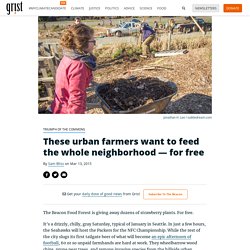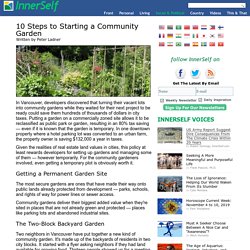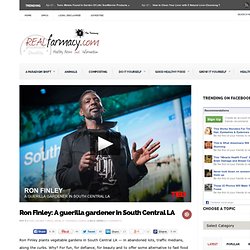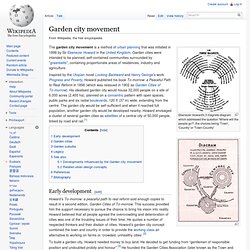

These urban farmers want to feed the whole neighborhood — for free. The Beacon Food Forest is giving away dozens of strawberry plants.

For free. It’s a drizzly, chilly, gray Saturday, typical of January in Seattle. In just a few hours, the Seahawks will host the Packers for the NFC Championship. While the rest of the city slugs its first tailgate beer of what will become an epic afternoon of football, 60 or so unpaid farmhands are hard at work. They wheelbarrow wood chips, prune pear trees, and remove invasive species from the hillside urban garden, preparing it for spring. The work party breaks for lunch; people congregate and laugh while a drummer and clarinetist improvise a blues jam.
Article continues below This is kinda how BFF works: Create abundance, share abundance. The Beacon Food Forest is a community gathering space overflowing with yummy, organic perennial plants in Seattle’s Beacon Hill neighborhood, about 2.5 miles south of downtown. Seemingly every rag and zine was writing about this novel use of public space — Forbes, Gawker, Grist. 10 Steps to Starting a Community Garden. In Vancouver, developers discovered that turning their vacant lots into community gardens while they waited for their next project to be ready could save them hundreds of thousands of dollars in city taxes.

Putting a garden on a commercially zoned site allows it to be reclassified as public park or garden, resulting in an 80% tax saving — even if it is known that the garden is temporary. In one downtown property where a hotel parking lot was converted to an urban farm, the property owner is saving $132,000 a year in taxes. Given the realities of real estate land values in cities, this policy at least rewards developers for setting up gardens and managing some of them — however temporarily. For the community gardeners involved, even getting a temporary plot is obviously worth it. Getting a Permanent Garden Site The most secure gardens are ones that have made their way onto public lands already protected from development — parks, schools, and rights of way for power lines or sewer access.
Urban Gardening / Farming. Ron Finley: A guerilla gardener in South Central LA. Ron Finley plants vegetable gardens in South Central LA — in abandoned lots, traffic medians, along the curbs.

Why? For fun, for defiance, for beauty and to offer some alternative to fast food in a community where “the drive-thrus are killing more people than the drive-bys.” Eating HealthyGardeningGIYGrow Food Not Lawns Related Posts « How To Keep Your Home Garden Monsanto-Free Cancer Doctor Explains How Cooking with Turmeric Leads to Amazing Health Benefits » Farmin' in The Hood 2. Garden city movement. Ebenezer Howard's 3 magnets diagram which addressed the question 'Where will the people go?

', the choices being 'Town', 'Country' or 'Town-Country' The garden city movement is a method of urban planning that was initiated in 1898 by Sir Ebenezer Howard in the United Kingdom. Garden cities were intended to be planned, self-contained communities surrounded by "greenbelts", containing proportionate areas of residences, industry and agriculture.
Inspired by the Utopian novel Looking Backward and Henry George's work Progress and Poverty, Howard published his book To-morrow: a Peaceful Path to Real Reform in 1898 (which was reissued in 1902 as Garden Cities of To-morrow). His idealised garden city would house 32,000 people on a site of 6,000 acres (2,400 ha), planned on a concentric pattern with open spaces, public parks and six radial boulevards, 120 ft (37 m) wide, extending from the centre.
Early development[edit] To build a garden city, Howard needed money to buy land. Garden cities[edit] Webinar - Ogrodnik Miejski - relacja. Webinar odbył się zgodnie z zapowiedzią w czwartkowy wieczór.

Dziś mam dla Was zapis wideo i czatu – do obejrzenia i przeczytania kiedy tylko będziecie mieli ochotę Przede wszystkim – dziękuję wszystkim za tak liczną obecność! Przez cały webinar przewinęło się 220 osób! Uważam to za mały sukces Dla tych co przeoczyli ten wykład lub po prostu chcą go obejrzeć jeszcze raz, wklejam poniżej zapis wideo: Jeszcze raz przepraszam Was za początkowe problemy techniczne, ale tak to czasem jest, że technologia odmawia posłuszeństwa W każdym razie cieszę się, że udało się je ogarnąć i mogłam podzielić się z Wami tą odrobiną wiedzy o ogrodnictwie miejskim Pozostałe materiały (wystarczy kliknąć w link aby pobrać): Przypomnę tylko, że spotkanie było organizowane przez grupę Cohabitat z Łodzi.
I jeszcze mały bonus dla tych, których ominęła część pierwsza spotkania o ogrodnictwie miejskim. Oraz reszta materiałów (wystarczy kliknąć w link aby pobrać):